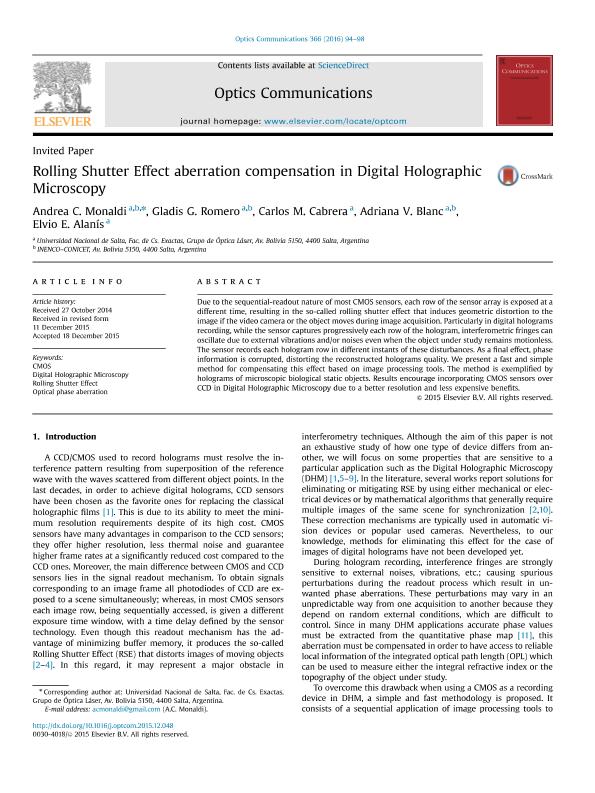Artículo
Rolling shutter effect aberration compensation in digital holographic microscopy
Monaldi, Andrea Carolina ; Romero, Gladis G.; Cabrera, Carlos M.; Blanc, Adriana V.; Alanís, Elvio E.
; Romero, Gladis G.; Cabrera, Carlos M.; Blanc, Adriana V.; Alanís, Elvio E.
 ; Romero, Gladis G.; Cabrera, Carlos M.; Blanc, Adriana V.; Alanís, Elvio E.
; Romero, Gladis G.; Cabrera, Carlos M.; Blanc, Adriana V.; Alanís, Elvio E.
Fecha de publicación:
05/2016
Editorial:
Elsevier Science
Revista:
Optics Communications
ISSN:
0030-4018
Idioma:
Inglés
Tipo de recurso:
Artículo publicado
Clasificación temática:
Resumen
Due to the sequential-readout nature of most CMOS sensors, each row of the sensor array is exposed at a different time, resulting in the so-called rolling shutter effect that induces geometric distortion to the image if the video camera or the object moves during image acquisition. Particularly in digital holograms recording, while the sensor captures progressively each row of the hologram, interferometric fringes can oscillate due to external vibrations and/or noises even when the object under study remains motionless. The sensor records each hologram row in different instants of these disturbances. As a final effect, phase information is corrupted, distorting the reconstructed holograms quality. We present a fast and simple method for compensating this effect based on image processing tools. The method is exemplified by holograms of microscopic biological static objects. Results encourage incorporating CMOS sensors over CCD in Digital Holographic Microscopy due to a better resolution and less expensive benefits.
Archivos asociados
Licencia
Identificadores
Colecciones
Articulos(INENCO)
Articulos de INST.DE INVEST.EN ENERGIA NO CONVENCIONAL
Articulos de INST.DE INVEST.EN ENERGIA NO CONVENCIONAL
Citación
Monaldi, Andrea Carolina; Romero, Gladis G.; Cabrera, Carlos M.; Blanc, Adriana V.; Alanís, Elvio E.; Rolling shutter effect aberration compensation in digital holographic microscopy; Elsevier Science; Optics Communications; 366; 5-2016; 94-98
Compartir
Altmétricas



